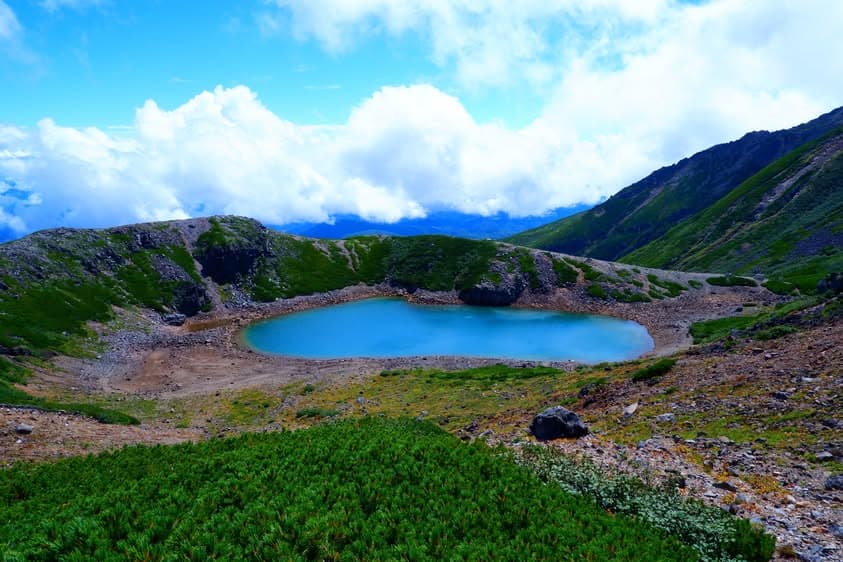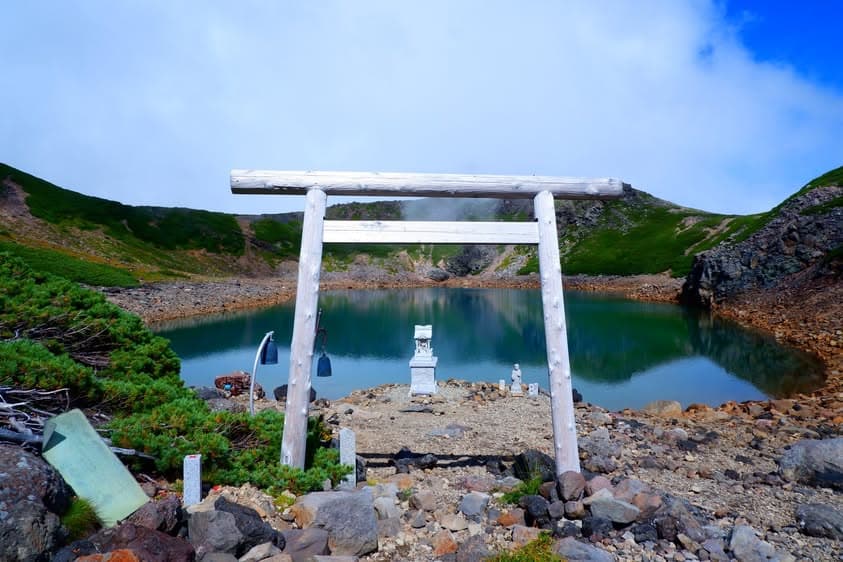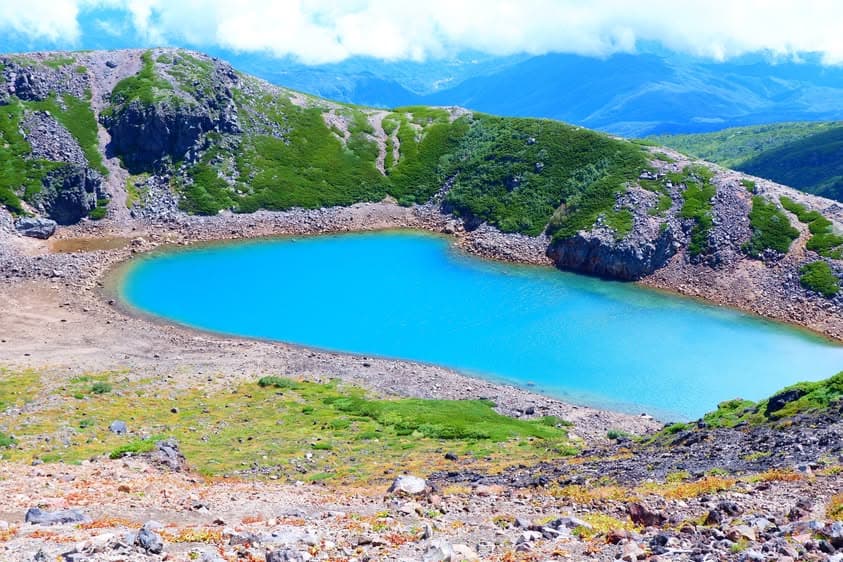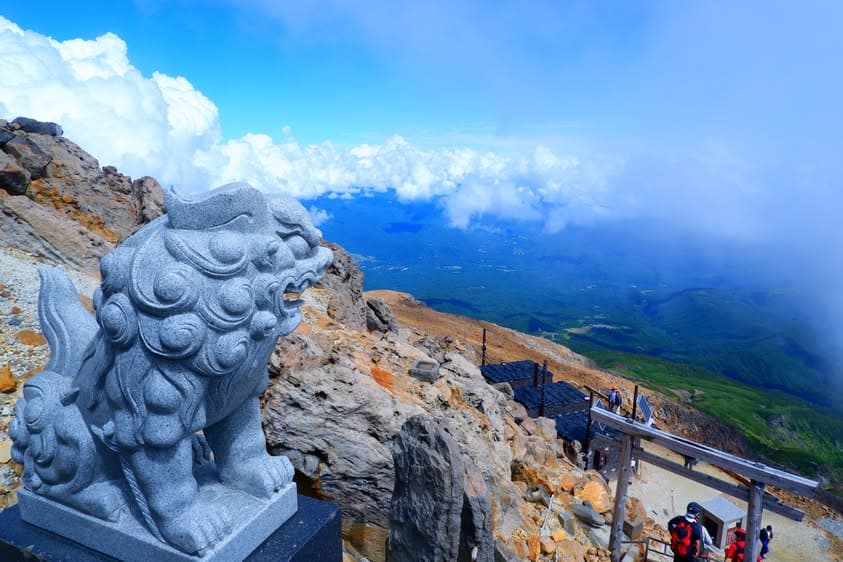Mount Ontake: Ascend Japan's Sacred Volcano to the Mystical Blue of Sannoko Lake
7/8/2025
21views

Japan is home to many mountains that are not only breathtakingly beautiful but also deeply imbued with ancient spiritual beliefs, revered as "sacred mountains." Among these, Mount Ontake (御嶽山, Ontake-san), majestically straddling the border of Gifu and Nagano Prefectures, stands out as a truly "living mountain" with a unique history and profound spiritual significance.
Mount Ontake, towering at 3,067 meters, is one of Japan's foremost sacred peaks, revered as an object of mountain worship since ancient times.Having overcome the challenges of the 2014 eruption, it continues to draw numerous hikers and pilgrims, offering an opportunity to connect with its magnificent nature and sacred atmosphere.Among the mystical crater lakes near its summit, San-no-ike (三ノ池) captivates visitors with its particularly beautiful cobalt-blue waters.A climb up Mount Ontake is more than just a physical challenge; it is an experience that allows you to feel the profound spiritual culture of Japan and the immense power of nature, truly stirring the soul. This guide will provide a comprehensive overview of Mount Ontake's unparalleled allure, what you can experience there, and why this guide is essential for foreign travelers to safely and deeply explore this sacred mountain.
Contents
- 01.|Mount Ontake's Unparalleled Charm: A Mystical Landscape Woven by Faith and Volcano
- 02.|Mount Ontake Ascent and San-no-ike Experience Details: Routes and Highlights
- 03.|Why a Guide is Essential for Foreign Travelers: To Safely and Deeply Experience the Sacred Mountain
- 04.|Tips and Precautions for Your Visit
- 05.|Conclusion
Mount Ontake's Unparalleled Charm: A Mystical Landscape Woven by Faith and Volcano
A Sacred Site of Mountain Worship
Mount Ontake is counted among Japan's Three Sacred Mountains, alongside Mount Fuji and Mount Haku (or Mount Tate), and is the most actively worshipped mountain in Japan.For over 30,000 years, it has been revered as a sacred mountain, becoming a religious sanctuary where ancient Japanese mountain worship, Buddhism, Shinto, and Shugendo (a syncretic religion blending Buddhist, Shinto, and animistic elements) have converged . Even today, many pilgrims in white robes can be seen ascending the mountain, chanting prayers, as the climb itself is considered a form of spiritual practice . The countless stone monuments and shrines scattered near the summit further emphasize the unique sacred atmosphere of this mountain.Mount Ontake truly embodies a "living mountain," preserving its sanctity to this day.

A Unique Landscape Forged by Volcanic Activity
Mount Ontake is a large composite volcano with a series of peaks exceeding 2,800 meters, stretching 3.5 km from north to south. Its rugged yet beautiful crater area creates a unique landscape unlike any other mountain.Particularly striking are the five crater lakes dotted around the summit: Ichi-no-ike, Ni-no-ike, San-no-ike, Yon-no-ike, and Go-no-ike, each displaying a distinct character.Among them, San-no-ike is especially captivating with its mystical cobalt-blue waters, enchanting all who behold it . The color of the water changes with the seasons and light, offering a different view each time. Furthermore, Ni-no-ike is located at an elevation of 2,905 meters, making it the highest mountain lake in Japan . These crater lakes are a testament to Mount Ontake's active volcanic nature, allowing visitors to experience both the raw power and the serene beauty of nature.

Recovery from the 2014 Eruption and a Living Mountain Today
Mount Ontake suffered extensive damage from a phreatic eruption on September 27, 2014 . This tragedy resulted in the worst post-war volcanic disaster in Japan, claiming many precious lives . However, Mount Ontake has since embarked on a path of recovery.Currently, the hiking trails have been restored, and safety measures have been significantly enhanced . Notably, wearing a helmet is mandatory for all climbers on Mount Ontake, a regulation introduced after the 2014 eruption where falling rocks caused severe casualties.This rule underscores the mountain's active volcanic nature and Japan's strict commitment to safety. The sight of nature's overwhelming power, coupled with the resilience of people who accept and coexist with it, strongly conveys that Mount Ontake remains a "living mountain" today.
360-Degree Panoramic Views
From Kengamine (剣ヶ峰), the highest peak of Mount Ontake, a breathtaking 360-degree panorama unfolds . You can gaze upon the majestic Japanese Alps, including the Northern, Central, and Southern Alps, and on clear days, even catch a glimpse of Mount Fuji in the distance . The beauty of the sunrise and the sea of clouds stretching below are particularly unforgettable moments for climbers .

Mount Ontake Ascent and San-no-ike Experience Details: Routes and Highlights
Mount Ontake offers several climbing routes, each with different difficulty levels and attractions. While day trips are possible, an overnight stay at a mountain hut is recommended to more deeply appreciate the mountain's charm and enjoy the high-altitude starry skies and sunrise .
Typical Routes
The main access routes to Mount Ontake are the Otaki-guchi (王滝口) via Tanohara and Kurosawa-guchi (黒沢口) via Ontake Ropeway on the Nagano Prefecture side, and the Osakaguchi (小坂口) starting from Nigorigo Onsen on the Gifu Prefecture side .
Otaki-guchi Route (via Tanohara): Starting from Tanohara parking lot at an elevation of 2,180 meters, this is the most popular and shortest route to the summit . The standard round-trip time is 4 hours and 50 minutes, making it relatively easy to reach the summit .
Kurosawa-guchi Route (via Ontake Ropeway): This route is popular among general tourists as it allows easy access to Iimori Kogen Station (飯森高原駅) at 2,150 meters via the Ontake Ropeway . The ascent to the summit takes about 4 hours from Iimori Kogen Station, with a standard round-trip time of 5 hours and 30 minutes.
Osakaguchi Route (from Nigorigo Onsen): Starting from Nigorigo Onsen (濁河温泉) at 1,780 meters, this is the only ancient pilgrimage route opened from the Hida side (Gifu Prefecture).This route has a greater elevation difference compared to others, taking approximately 4 hours and 50 minutes to Kengamine, with a standard round-trip time of 8 hours and 55 minutes, making it a more challenging course.
Access to San-no-ike is generally via the route passing through Ni-no-ike .
Highlights at Key Points
Ontake Ropeway: Provides easy access to higher altitudes from Shikanose Station to Iimori Kogen Station, offering a vast panorama of the Central Alps, Northern Alps, and Mount Norikura from the summit station observatory .
Tanohara: The trailhead for the Otaki-guchi route, where the Satomiya (lower shrine) of Ontake Shrine is located, serving as a base for climbing.
Hachigome (8th Station), Kugome (9th Station), and Summit: As you ascend the trail, the atmosphere of mountain worship becomes more pronounced, with numerous spiritual monuments and shrines scattered along the path.
Kengamine: The highest peak of Mount Ontake, offering a breathtaking 360-degree view .
Ni-no-ike: The highest lake in Japan by elevation, its clear waters are captivating .
San-no-ike: A short detour from Ni-no-ike reveals this lake with its mystical cobalt-blue waters . Spending quiet time by the lake is one of the highlights of a Mount Ontake ascent.
Mountain Hut Stay (e.g., Go-no-ike Goya): Located at the 9th station on the Nigorigo Onsen route, Go-no-ike Goya is a popular mountain hut with a lounge and terraces offering superb views of Mount Marishiten and Go-no-ike . An overnight stay at high altitude provides a precious opportunity to experience a sky full of stars and the sunrise up close, as well as interact with other climbers.
The physical and mental challenge of high-altitude trekking, the unique volcanic environment, and the profound sense of accomplishment upon conquering a sacred mountain offer an unparalleled experience unique to Mount Ontake.
Why a Guide is Essential for Foreign Travelers: To Safely and Deeply Experience the Sacred Mountain
Mount Ontake, despite its allure, presents several unique challenges for foreign travelers. To safely and deeply experience this sacred mountain, the presence of a knowledgeable guide is indispensable.
Post-Eruption Safety Information and Access Restrictions
Since the 2014 eruption, strict safety measures have been implemented on Mount Ontake . While the eruption alert level has been lowered to "Level 1: Note that it is an active volcano," sudden emissions of volcanic ash are still possible within the Jigokudani crater, and access to the crater area is prohibited . It is crucial to know the locations of evacuation shelters and emergency procedures in advance.Furthermore, ropeway and bus services can vary depending on the season and weather, and reservations may be difficult during peak times . A guide well-versed in local conditions is essential for accurately grasping real-time information and making appropriate decisions.
Cultural Background of Mountain Worship
Mount Ontake is not merely a natural mountain but a sacred peak with a deep history of mountain worship . The stone monuments, shrines, and actions of pilgrims near the summit carry cultural meanings that might be difficult to understand without a guide . A guide who can deeply explain the history and spirituality of Japanese mountain worship will enrich your experience on this sacred mountain beyond mere hiking.
Risk of Altitude Sickness and Health Management
Mount Ontake is a high mountain exceeding 3,000 meters, and symptoms of altitude sickness can easily occur, especially when ascending rapidly by ropeway . Understanding and practicing early responses to altitude sickness symptoms (headache, nausea, dizziness), maintaining an appropriate pace, and staying well-hydrated are crucial for a safe ascent. An experienced guide can constantly monitor climbers' conditions and provide timely advice to minimize the risk of altitude sickness.
Language and Information Barriers
Trail signs, mountain hut information, and volcanic regulations in Japan are still primarily in Japanese.Real-time weather and trail conditions are often provided on Japanese websites and local bulletin boards, posing a significant barrier for foreign travelers . A multilingual guide can accurately convey this information, ensuring climbers feel secure and well-informed.
The Value of a Professional Guide
For a safe and profound experience on a special mountain like Mount Ontake, the presence of a professional guide is indispensable.
Safety Management Expert: A guide prioritizes your safety with the latest information on volcanic activity, trail condition assessment, altitude sickness prevention, and crisis management skills. You can focus on the sacred nature of Mount Ontake with peace of mind .
Deep Cultural and Natural Insights: Beyond simple trail guidance, a guide provides profound stories and learning about the history of Ontake worship, volcanic mechanisms, and alpine flora that are not found in guidebooks .
Flawless Logistics Arrangement: A guide handles all arrangements, from ropeway and bus reservations to securing mountain hut accommodations, optimal route selection, and essential gear advice .
Bilingual Support: Perfect communication in English and French ensures a fulfilling climbing experience without language barriers.
Extensive Experience and Knowledge: Leveraging experience and knowledge gained from exploring various Japanese mountains, a guide elevates this special sacred mountain ascent into a deeper, more personal experience.
Tips and Precautions for Your Visit
Best Season
The main climbing season for Mount Ontake generally runs from mid-July to mid-October . During this period, major trails are open, and weather conditions are often suitable for climbing . Late September to early October is particularly recommended, as Mount Ontake is enveloped in stunning autumn foliage, with Japanese rowan and Erman's birch trees turning vibrant red and yellow .
Essential Gear
Proper gear is crucial for climbing Mount Ontake.
Helmet: Mandatory for all climbers.Helmets can be rented at several locations, including the Kiso Ontake Tourism Office in front of Kiso-Fukushima Station, the Ontake Ropeway shop, and Gyojasan-so mountain hut at the 7th station of the Kurosawa-guchi route (rental fee around 2,000 JPY).
Hiking Boots: Sturdy, waterproof hiking boots are recommended to handle various terrains, including rocky areas and slippery wooden paths.
Rainwear: Mountain weather can change rapidly, so a waterproof and windproof two-piece rain suit is essential.
Warm Clothing: Layering is crucial to adapt to sudden temperature changes. Include a moisture-wicking base layer, an insulating mid-layer (like fleece), and a waterproof/windproof outer shell.Even in summer, temperatures near the summit can drop below freezing, so adequate cold weather protection is necessary .
Headlamp: Always carry a headlamp, even for day hikes, in case of unexpected delays.
Food and Water: Carry sufficient water (e.g., 2.5 liters) and high-energy snacks (bars, gels, tablets).
Other Essentials: Map and compass, or a reliable GPS device/smartphone app (e.g., YAMAP) , first-aid kit , gloves , sunglasses , sunscreen, trash bags , and a portable charger for electronic devices.
Altitude Sickness Prevention
To avoid altitude sickness, a realistic plan and prior physical conditioning are important. Symptoms of altitude sickness can easily occur, especially when ascending rapidly by ropeway. Move slowly and stay well-hydrated . If you feel unwell, rest without pushing yourself, and consider descending if necessary.
Checking Volcanic Regulations
Before your hike, it is essential to always check the latest volcanic information and restricted access areas from the Japan Meteorological Agency (JMA) website and local government websites, such as Otaki Village's website.Trails may be closed without notice due to bad weather or changes in volcanic activity .
Mountain Hut Reservations
Mountain huts on Mount Ontake (especially Go-no-ike Goya) operate on a reservation-only basis.They can be crowded, especially on weekends and during peak seasons, so early booking is essential.Unlike some mountain huts in Western countries, it is uncommon to stay at Japanese mountain huts without a prior reservation, a cultural difference that foreign climbers should be aware of.
Safety Measures
Beware of Sudden Weather Changes: Mountain weather is unpredictable, so always check the latest forecast and be prepared for sudden rain, strong winds, and temperature drops .
Early Start: Plan your hike with ample time and start early to better handle unexpected situations.
Submit a Climbing Plan (Tozan-todoke): This is an important safety practice for hiking in Japan, helping to expedite search and rescue operations in case of an emergency . You can submit it online (via "Yamato to Shizen Network Compass" or "YAMAP" app) or at designated posts at trailheads.
Exercise Caution for Solo Hiking: Especially for less experienced climbers, it is strongly recommended to avoid solo hiking and instead go with an experienced companion or hire a guide.
Understand Japanese Hiking Etiquette: Familiarize yourself with and adhere to Japanese hiking manners and etiquette, such as greeting other climbers , taking all trash with you , respecting plants and wildlife , and paying cooperation fees at mountain hut toilets.Notably, "bullet climbing" (Dangan-tozan), which involves attempting to reach the summit overnight without adequate rest or mountain hut stays, is highly dangerous and strongly discouraged.
Conclusion
Mount Ontake is a truly unique mountain in Japan, where magnificent natural beauty, profound spiritual significance, and challenging climbing experiences converge. The panoramic views from Kengamine, the mystical crater lakes, and the ancient culture of mountain worship will leave visitors with deep impressions and unforgettable memories.To ensure a safe and fulfilling ascent of this active volcano, thorough preparation and strict adherence to safety measures, such as the mandatory helmet use and continuous monitoring of volcanic alert levels, are paramount. Furthermore, submitting a climbing plan, obtaining appropriate insurance, and understanding Japanese hiking manners and cultural etiquette will not only enhance safety but also foster good relations with locals and improve the overall quality of your journey.Why not embark on a journey to Mount Ontake, a living sacred mountain that has overcome its volcanic past, and experience the profound spirituality and magnificent power of nature in Japan with all your senses?For foreign travelers, planning a Mount Ontake ascent can be challenging. A professional guide can ensure a safe and exceptional experience. By planning and guiding a fully customized mountain adventure tailored to your skills and desires, we can help you create unforgettable memories on this sacred Japanese mountain.